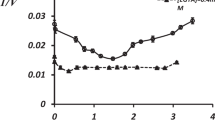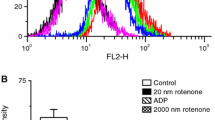Abstract
The generation of superoxide radicals from xanthine oxidase-hypoxanthine in a particulate fraction of gerbil cerebral cortex influenced the activity of the synaptic enzyme adenylate cyclase, as well as Mn2+- and Na+,K+-sensitive forms of ATPase. Low concentrations of xanthine oxidase actually elevated the sensitivity of adenylate cyclase to GTP, GTP + norepinephrine (NE), and forskolin but not significantly to Mn2+. Higher levels of xanthine oxidase elicited a marked inhibition of these responses. The stimulation of adenylate cyclase mechanisms requiring GTP (GTP, forskolin, and NE) was more susceptible than was Mn2+, suggesting that the guanine nucleotide stimulatory protein was more vulnerable to free radical attack than the catalytic site of adenylate cyclase. superoxide dismutase (SOD), but not catalase, partially protected the forskolin-sensitive enzyme from the action of xanthine oxidase-hypoxanthine. A combination of SOD plus catalase preserved enzyme responses to forskolin. In comparison, additions of SOD plus mannitol or catalase plus flunarizine were less effective. The sensitivity of the particulate ATPase to Mn2+ was more labile to the consequence of superoxide formation than Na+, K+-ATPase. In this regard the Ca2+, Mg2+ sensitivity of the enzyme was reduced only to a marginal extent. The findings might be analogous toin vivo data in which cerebral adenylate cyclase and Na+, K+-ATPase are damaged following postischemic reperfusion in gerbils, a process thought to be mediated by free radicals.
Similar content being viewed by others
References
Aust, S. D., and White, B. C. (1985). Iron chelation prevents tissue injury following ischemia.Adv. Free Radical Biol. Med. 1: 1–17.
Cech, S. Y., and Maguire, M. E. (1982). Magnesium regulation of the beta-receptor-adenylate cyclase complex. 1. Effects of manganese on receptor binding and cyclase activation.Mol. Pharmacol. 22: 267–273.
Chan, P. H., and Fishman, R. A. (1985). Free fatty acids, oxygen free radicals and membrane alterations in brain ischemia and injury. In Plum, F., and Pulsinelli, W. (eds.),Cerebrovascular Diseases, Raven Press, New York, pp. 161–171.
Christie-Pope, B. C., and Palmer, G. C. (1986). Modulation of ischemic-induced damage to cerebral adenylate cyclase in gerbils by calcium channel blockers.Metab. Brain Dis. 1: 249–263.
Christie-Pope, B. C., Palmer, G. C., Poulakos, L., Medina, M. A., Callahan, A. S., III, and Palmer, S. J. (1984). Regional cyclic AMP systems during secondary ischemia in gerbils: Influence of anesthetic agents.Exp. Neurol. 84: 494–511.
Deshpande, J. K., and Wieloch, T. (1986). Flunarizine, a calcium entry blocker, ameliorates ischemic brain damage in the rat.Anesthesiology 64: 215–224.
Doherty, J. D., Salem, N., Lauter, C. J., and Trams, E. G. (1983). Mn2+ -stimulated ATPase in rat brain.Neurochem. Res. 8: 493–500.
Duchon, A., Chevion, M., Carney, J. M., and Floyd, R. A. (1987). Oxygen free radical mediated ischemiareperfusion damage to gerbil brain.Toxicologist 7: 129.
Enseleit, W., Domer, F. R., Jarrot, D. M., and Baricos, W. H. (1984). Cerebral phospholipid content and Na+,K+-ATPase activity during ischemia and postischemic reperfusion in the Mongolian gerbil. J.Neurochem. 43: 320–327.
Gilbert, J. C., and Sawas, A. H. (1983). ATPase activities and lipid peroxidation in rat cerebral cortex synaptosomes.Arch. Int. Pharmacodyn. Ther. 263: 189–196.
Goldberg, W. J., Dorman, R. V., Dabrowiecki, Z., and Horrocks, L. A. (1985). The effects of ischemia and CDPamines on Na+,K+ -ATPase and acetylcholinesterase activities in rat brain.Neurochem. Pathol. 3: 237–248.
Halliwell, B., and Gutteridge, J. M. (1986). Iron and free radical reactions: Two aspects of antioxidant protection.Trends Biochem. Sci. 11: 372–375.
Hammond, B., Kontos, H. A., and Hess, M. L. (1985). Oxygen radicals in the adult respiratory distress syndrome, in myocardial ischemia and reperfusion injury, and in cerebral vascular disease.Can. J. Physiol. Pharmacol. 63: 173–187.
Holmes, B., Brogden, R. N., Heel, R. C., Speight, T. M., and Avery, G. S. (1984). Flunarizine: A review of its pharmacodynamic and pharmacokinetic properties and therapeutic use.Drugs 27: 6–44.
Jolly, S. R., Kane, W. J., Bailie, M. B., Abrams, G. D., and Lucchesi, B. R. (1984). Canine myocardial reperfusion injury its reduction by the combined administration of superoxide dismutase and catalase.Circ. Res. 54: 277–285.
Kontos, H. A. (1985). Oxygen radicals in cerebral vascular injury.Circ. Res. 57, 508–516.
Kramer, K., Rademaker, B., Rozendal, W. H. M., Timmerman, H., and Bast, A. (1986). Influence of lipid peroxidation on beta-adrenoreceptors.FEBS Lett. 198: 80–84.
Kubo, K., Yoshitake, I., Kumada, Y., Shuto, K., and Nakamizo, N. (1984). Radical scavenging action of flunarizine in rat brain in vitro.Arch. Int. Pharmacodyn. Ther. 272: 283–295.
Lowry, O. H., Rosebrough, N. J., Farr, A. L., and Randall, R. J. (1951). Protein measurement with the Folin phenol reagent.J. Biol. Chem. 193: 265–275.
Lust, W. D., and Passonneau, J. V. (1979). Cyclic nucleotide levels in brain during ischemia and recirculation. In Palmer, G. C. (ed.),Neuropharmacology of Cyclic Nucleotides, Urban & Schwarzenberg, Baltimore-Munich, pp. 228–252.
Lust, W. D., Dye, E., Deaton, A. V., and Passonneau, J. V. (1976). A modified cycle AMP binding assay.Anal. Biochem. 72: 8–15.
McCord, J. M. (1985). Oxygen-derived free radicals in postischemic tissue injury.N. Engl. J. Med. 312: 159–163.
Meyer, F. B., Sundt, T. M., Jr., Yanagihara, T., and Anderson, R. E. (1987). Focal cerebral ischemia: Pathophysiologic mechanisms and rationale for future avenues of treatment.Mayo Clin. Proc. 62: 35–55.
Minotti, G., and Aust, S. D. (1987). The requirement for iron (III) in the initiation of lipid peroxidation by iron (II) and hydrogen peroxide.J. Biol. Chem. 262: 1098–1104.
Mrsulja, B. B., Micic, D. V., and Stefanovich, V. (1985). Propentofylline and postischemic brain edema: Relation to Na+-K+-ATPase activity.Drug. Dev. Res. 6: 339–344.
Palmer, G. C. (1983). Effects of psychoactive drugs on cyclic nucleotides in the central nervous system.Prog. Neurobiol. 21: 1–133.
Palmer, G. C., Palmer, S. J., Christie-Pope, B. C., Callahan, A. S., Taylor, M. D., and Eddy, L. J. (1985). Classification of ischemic-induced damage to Na+,K+-ATPase in gerbil forebrain.Neuropharmacology 24: 509–516.
Palmer, G. C., Jones, D. J., Palmer, S. J., Christie-Pope, B. C., and Poulakos, L. (1986). Further probes into the molecular sites of damage to cerebral adenylate cyclase following post-ischemic reperfusion.Neurochem. Pathol. 5: 1–24.
Palmer, G. C., Palmer, S. J., and Christie-Pope, B. C. (1987). Protective action of calcium channel blockers on Na+,K+-ATPase in gerbil cerebral cortex following ischemia.J. Neurosci. Res. 18 (in press).
Parks, D. A., and Granger, D. N. (1986). Xanthine oxidase: Biochemistry, distribution and physiology.Acta Physiol. Scand. (Suppl.)548: 87–99.
Schwartz, J. P., Mrsulja, B. B., Mrsulja, B. J., Passonneau, J. V., and Klatzo, I. (1976). Alterations of cyclic nucleotide-related enzymes and ATPase during unilateral ischemia and recirculation in gerbil cerebral cortex.J. Neurochem. 27: 101–107.
Seamon, K. B., and Daly, J. W. (1983). Forskolin, cyclic AMP and cellular physiology.Trends Pharmacol. Sci. 4: 120–123.
Stahl, W. L. (1984). (Na+ + K+)-ATPase: Function, structure and conformations.Ann. Neurol. (Suppl.)16: S121–S127.
Taylor, M. D., Palmer, G. C., and Callahan, A. S., III (1984). Protective action by methylprednisolone, allopurinol and indomethacin against stroke-induced damage to adenylate cyclase in gerbil cerebral cortex.Stroke 15: 329–335.
Taylor, M. D., Mellert, T. K., Parmentier, J. L., and Eddy, L. J. (1985). Pharmacological protection of reoxygenation damage to in vitro brain slice tissue.Brain Res. 347: 268–273.
Author information
Authors and Affiliations
Rights and permissions
About this article
Cite this article
Palmer, G.C. Free radicals generated by xanthine oxidase-hypoxanthine damage adenylate cyclase and ATPase in gerbil cerebral cortex. Metab Brain Dis 2, 243–257 (1987). https://doi.org/10.1007/BF00999695
Received:
Accepted:
Issue Date:
DOI: https://doi.org/10.1007/BF00999695




